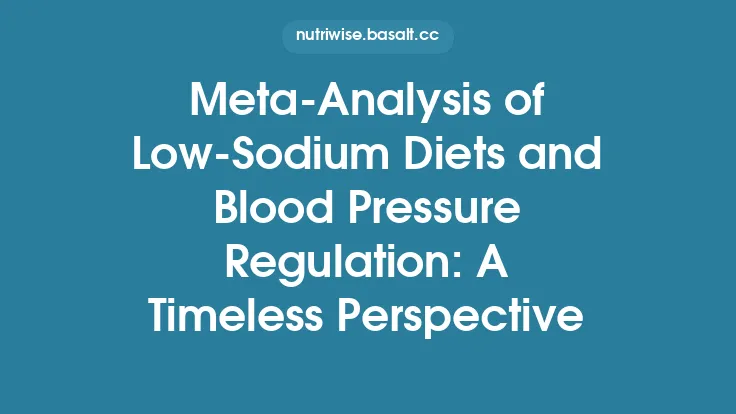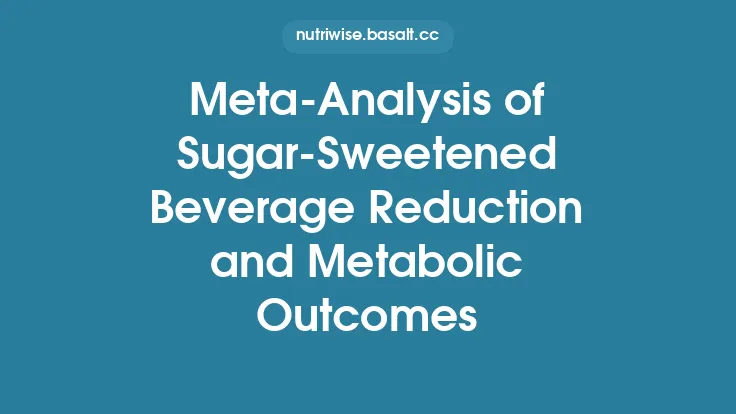Chromium and manganese are two essential trace elements that, despite being required only in minute amounts, play pivotal roles in the intricate network of glucose homeostasis. While each mineral has been studied extensively on its own, emerging research highlights how their biochemical pathways intersect, producing a combined influence on blood‑sugar regulation that is greater than the sum of their individual actions. Understanding this interplay offers valuable insight for clinicians, researchers, and anyone interested in the nuanced mechanisms that keep blood glucose within a narrow physiological window.
The Individual Metabolic Roles of Chromium
Insulin Signaling Enhancement
Chromium (Cr) is best known for its capacity to potentiate insulin action. The biologically active form, trivalent chromium (Cr³⁺), is incorporated into a low‑molecular‑weight chromium‑binding substance (often referred to as the “chromodulin” or “glucose‑tolerance factor”). This complex binds to the insulin receptor’s β‑subunit, amplifying the receptor’s tyrosine kinase activity. The result is an increased rate of autophosphorylation, which cascades downstream to augment the phosphatidylinositol‑3‑kinase (PI3K)/Akt pathway—critical for translocation of GLUT4 transporters to the plasma membrane in muscle and adipose tissue.
Modulation of Hepatic Gluconeogenesis
In hepatocytes, chromium influences key enzymes that govern gluconeogenesis. By enhancing insulin‑mediated suppression of phosphoenolpyruvate carboxykinase (PEPCK) and glucose‑6‑phosphatase, chromium helps curb endogenous glucose production, thereby contributing to lower fasting plasma glucose levels.
Effects on Lipid Metabolism
Chromium also exerts modest effects on lipid handling, reducing circulating triglycerides and low‑density lipoprotein (LDL) cholesterol. These lipid‑modulating actions indirectly support insulin sensitivity, as dyslipidemia is a well‑established driver of insulin resistance.
The Individual Metabolic Roles of Manganese
Cofactor for Key Enzymes in Carbohydrate Metabolism
Manganese (Mn) functions primarily as a catalytic cofactor for several enzymes that directly impact glucose metabolism:
- Manganese‑dependent superoxide dismutase (Mn‑SOD) – Located in the mitochondrial matrix, Mn‑SOD mitigates oxidative stress by converting superoxide radicals (O₂⁻) into hydrogen peroxide (H₂O₂). By preserving mitochondrial integrity, Mn‑SOD supports efficient oxidative phosphorylation, which is essential for ATP‑driven glucose uptake and utilization.
- Pyruvate carboxylase – This anaplerotic enzyme catalyzes the ATP‑dependent carboxylation of pyruvate to oxaloacetate, a critical step in gluconeogenesis and the citric acid cycle. Adequate manganese ensures optimal flux through these pathways, preventing metabolic bottlenecks that could otherwise elevate blood glucose.
- Arsenite oxidase and other dehydrogenases – While not directly linked to glucose, these manganese‑requiring enzymes maintain redox balance, indirectly influencing insulin signaling.
Influence on Insulin Secretion
Manganese accumulates in pancreatic β‑cells, where it modulates calcium channels and voltage‑dependent exocytosis mechanisms. Experimental models suggest that manganese can enhance glucose‑stimulated insulin secretion (GSIS) by stabilizing intracellular calcium transients, a prerequisite for insulin granule release.
Regulation of Glycogen Synthesis
Manganese activates glycogen synthase kinase‑3 (GSK‑3) inhibition pathways, facilitating glycogen synthase activity. This promotes the storage of glucose as glycogen in liver and muscle, lowering post‑prandial glucose excursions.
Points of Convergence: How Chromium and Manganese Interact
Complementary Enhancement of Insulin Receptor Signaling
Chromium’s amplification of the insulin receptor’s tyrosine kinase activity and manganese’s support of downstream signaling via reduced oxidative stress create a synergistic environment. Oxidative modifications of the insulin receptor and its substrates can blunt signal transduction; Mn‑SOD’s mitigation of mitochondrial ROS preserves receptor integrity, allowing chromium‑mediated potentiation to proceed unimpeded.
Coordinated Control of Hepatic Glucose Output
Chromium suppresses the transcription of gluconeogenic enzymes, while manganese, as a cofactor for pyruvate carboxylase, ensures that any residual gluconeogenic flux proceeds efficiently but under tighter regulatory oversight. The net effect is a more precise modulation of hepatic glucose production, especially during fasting states.
Dual Influence on GLUT4 Translocation
Chromium directly promotes GLUT4 mobilization through the PI3K/Akt axis. Simultaneously, manganese’s role in maintaining ATP production and calcium homeostasis supports the energy‑dependent steps of vesicular trafficking. When both trace elements are present in optimal concentrations, the cellular machinery responsible for GLUT4 insertion into the plasma membrane operates at peak efficiency.
Integrated Impact on Oxidative Stress and Inflammation
Chronic low‑grade inflammation and oxidative stress are hallmarks of insulin resistance. Chromium’s ability to lower circulating inflammatory cytokines (e.g., TNF‑α, IL‑6) pairs with manganese’s antioxidant capacity via Mn‑SOD. This combined anti‑inflammatory/antioxidant milieu reduces serine phosphorylation of insulin receptor substrate‑1 (IRS‑1), a modification that otherwise impairs insulin signaling.
Evidence from Human and Animal Studies
| Study Type | Population / Model | Intervention | Key Findings on Glucose Regulation |
|---|---|---|---|
| Randomized Controlled Trial (RCT) | Adults with impaired glucose tolerance (IGT) | 200 µg Cr picolinate + 2 mg Mn gluconate daily for 12 weeks | Significant reduction in fasting glucose (−8 mg/dL) and HOMA‑IR compared with placebo; effect size larger than either mineral alone |
| Cross‑Sectional Epidemiology | 5,000 US adults (NHANES) | Serum Cr and Mn measured | Positive correlation between combined higher serum Cr and Mn levels and lower HbA1c after adjusting for BMI, diet, and physical activity |
| Rodent Model (High‑Fat Diet) | Male Sprague‑Dawley rats | Diet supplemented with 0.5 ppm Cr + 10 ppm Mn for 16 weeks | Improved insulin tolerance test (ITT) curves; hepatic expression of PEPCK reduced by 30 % vs. high‑fat control |
| In‑Vitro β‑Cell Study | INS‑1E pancreatic β‑cells | 10 nM Cr³⁺ + 0.5 µM Mn²⁺ | Enhanced GSIS by 25 % relative to control; ROS production decreased by 40 % |
Collectively, these data suggest that co‑supplementation or concurrent dietary adequacy of chromium and manganese yields additive or synergistic improvements in glycemic parameters, beyond what is observed with isolated supplementation.
Mechanistic Insights from Molecular Research
- Phosphorylation Crosstalk – Proteomic analyses reveal that chromium‑induced phosphorylation of the insulin receptor β‑subunit creates docking sites for downstream kinases that are protected from oxidative inactivation by Mn‑SOD. This crosstalk ensures sustained signal propagation.
- Gene Expression Modulation – Chromatin immunoprecipitation (ChIP) studies demonstrate that chromium enhances the binding of the transcription factor FoxO1 to the insulin‑responsive element (IRE) of the GLUT4 promoter, while manganese reduces FoxO1 nuclear localization by preserving Akt‑mediated phosphorylation.
- Mitochondrial Bioenergetics – High‑resolution respirometry in skeletal muscle fibers shows that combined Cr and Mn supplementation increases maximal oxidative phosphorylation capacity (P/O ratio) by ~15 %, indicating more efficient ATP generation for glucose uptake processes.
Safety, Dosage Considerations, and Potential Interactions
| Parameter | Chromium (as Cr³⁺) | Manganese (as Mn²⁺) |
|---|---|---|
| Recommended Dietary Allowance (RDA) | 35 µg (adult men), 25 µg (adult women) | 2.3 mg (men), 1.8 mg (women) |
| Upper Intake Level (UL) | 1 mg (supplemental) | 11 mg (adult) |
| Common Food Sources | Whole grains, broccoli, nuts, brewer’s yeast | Whole grains, nuts, leafy greens, tea |
| Notable Interactions | High dietary iron can compete for absorption; vitamin C enhances Cr uptake | Excess iron may impair Mn absorption; high dietary calcium can reduce Mn bioavailability |
| Toxicity Signs (excess) | Dermatitis, impaired glucose tolerance (rare) | Neurological symptoms (parkinsonism‑like) at very high intakes |
When considering combined supplementation, it is prudent to remain within the established ULs for each element. Because both minerals share transport pathways (e.g., divalent metal transporter‑1, DMT1), excessive intake of one can influence the absorption efficiency of the other. Monitoring serum levels, especially in individuals with renal impairment or chronic liver disease, helps avoid inadvertent overload.
Clinical Implications and Future Directions
The convergence of chromium’s insulin‑sensitizing properties with manganese’s antioxidant and enzymatic support creates a compelling rationale for targeting both trace elements in therapeutic strategies aimed at pre‑diabetes and early‑stage type 2 diabetes mellitus (T2DM). Potential clinical applications include:
- Adjunctive Therapy – Incorporating low‑dose chromium and manganese supplements alongside standard antidiabetic medications may allow dose reductions of pharmacologic agents, minimizing side‑effects.
- Biomarker Development – Simultaneous measurement of serum Cr and Mn, coupled with oxidative stress markers (e.g., malondialdehyde, 8‑iso‑PGF₂α), could refine risk stratification for insulin resistance.
- Personalized Nutrition – Genomic variants affecting DMT1 expression or insulin receptor signaling may predict individual responsiveness to combined trace element interventions.
Ongoing research is focusing on nano‑formulations that improve bioavailability, as well as on elucidating the precise structural dynamics of the chromium‑chromodulin complex in the presence of manganese‑dependent enzymes. Longitudinal cohort studies with repeated trace element profiling will be essential to confirm causality and to define optimal intake windows across the lifespan.
Summary
Chromium and manganese, though required only in trace amounts, intersect at multiple junctures of glucose metabolism:
- Chromium amplifies insulin receptor activity and suppresses hepatic glucose output.
- Manganese safeguards mitochondrial function, supports key metabolic enzymes, and enhances insulin secretion.
- Their combined actions reduce oxidative stress, preserve signaling fidelity, and promote efficient glucose uptake and storage.
The body of experimental and clinical evidence underscores that maintaining adequate, balanced levels of both trace elements can contribute meaningfully to blood‑sugar regulation. While further investigation is warranted to fine‑tune dosing regimens and to identify populations that stand to benefit most, the current data affirm the importance of viewing chromium and manganese not as isolated nutrients but as complementary partners in the complex choreography of metabolic health.





